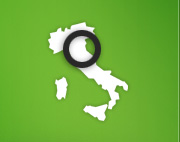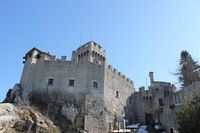History of San Marino
The oldest republic of the world
San Marino, located between the regions Emilia Romagna (province of Rimini) and the Marches (province Pesaro and Urbino), is considered to be the oldest republic of the world. The petty state had to resist numerous outsides attacks in its history of more than 1,700 years and has always been regarded as a refuge in times of crises. Today, approx. 32,000 inhabitants live on an area of 60.57 km²; an area that hasn’t changed since 1463.
Foundation of the republic on Monte Titano
According to legend, San Marino was founded by the national saint Marinus (in Italian: San Marino) in 301 AD. The mason of Dalmatian ancestry fled on Monte Titano due to the edicts enacted by Emperor Diocletian against the Christians. Other Christians followed Marinus leading to the foundation of a mixed secularised and religious community on the best protected area of the mountain. Marinus was named deacon by the Bishop of Rimini before his death, presumably in 366. First documented evidence of the existence of this community dates back to a script by the monk Eugippo, who lived between the 5th and 6th century. The sovereign territory was mentioned in a historic document from 885 according to which San Marino had never been in enemy control and thus had to remain in the possession of the San Marinese despite outside territorial claims.
Contested San Marino
Over the course of its history, San Marino has consistently been heavily contested, yet remained independent and tried to preserve its neutrality. This effort is reflected by the republic’s flag: The upper, white half stands for peace, the lower, azure half for freedom, while the republic’s coat of arms placed in the middle is adorned with the word “Libertas” (Latin for “freedom”). Nevertheless, San Marino has been part of various battles and disputes over the course of its history. It was between the lines of fire during the dispute of the Guelphs and the Gibellina in the 13th century. Subsequently, San Marino managed to resist the Malatesta with outside help and supported the church in 1461 to decisively defeat the influential, militant family two years later. Cardinal Alberoni, the papal legate of Romagna, invaded San Marino in 1739. Papal aid was needed for the republic to regain its independence four months later.
The republic as a place of refuge
In subsequent centuries, San Marino was held in high esteem. Napoleon Bonaparte respected the republic’s independence during his conquests in 1797 and expressed his friendship to the region. Even the Congress of Vienna conserved the petty state’s sovereignty. When Abraham Lincoln was offered honorary citizenship, he praised San Marino as one of the “most honoured countries in global history”.
San Marino also acted as a place of protection and refuge. Giuseppe Garibaldi, for example, retired to San Marino on 31 July 1849 while being pursued by the Austrians, laid down his weapons and left the republic before it could be surrounded by the Austrian army. Even though some San Marinese volunteers took part in several Italian wars of independence and the First World War, the republic remained neutral during the Second World War and took in around 100,000 refugees in 1943, eight times the population at that time. The active female suffrage was only introduced in 1960, the passive female suffrage in 1973.
Today, 60 % of San Marino’s direct or indirect earnings arise from tourism. The republic is free from debt and can offer free health care in light of rising tax revenue. The historic city centres of the capital, Monte Titano and the castle district of Borgo Maggiore were declared World Heritage Site by the UNESCO in 2008.



Tweet